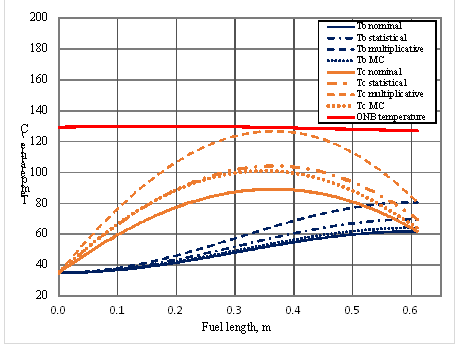
A Comparative Study for Uncertainty Assessments of Thermal-Hydraulic Calculations of the IRR-1
2Soreq Nuclear Research Center (SNRC)
The present study focuses on assessment of uncertainties using the engineering hot channel factors (EHCFs) and the Monte Carlo (MC) method for the Israeli Research Reactor-1 (IRR-1). The study exhibits uncertainties for cladding temperature, rising in coolant temperature and its effects on the onset of nucleate boiling (ONB). A comparison between the calculated margins using EHCFs to those obtained by the MC method is presented.
Introduction
Thermal-hydraulic analysis of a nuclear reactor is necessary in order to ensure safe operation. The analysis should include all the uncertainties that play a rule in the heat removal e.g. uncertainties of operational conditions, geometrical tolerances and fuel fabrication. Among different approaches for estimating safety limits [1], the present study focuses on the EHCFs and the MC technique. EHCFs can be further divided into three separate components, corresponding to their effect on the: heat flux from the fuel, temperature of the coolant water and fuel cladding temperature (Fq, Fb and Fh, respectively). Each component is a combination of the sub-factors, either by a multiplicative way or a statistical way. For further discussion see Ishay et al. [2].
Uncertainty assessment
Figure 1 shows the temperatures of the fluid and the cladding along the fuel. The nominal temperature is compared with the calculated temperature using the statistical, multiplicative and MC. The maximum margin of the cladding temperature is estimated to be 14 °C for the statistical and 37 °C for the multiplicative approach. The MC shows elevation of 12 °C. The maximum margin of the bulk temperature from the nominal value is 2.3, 7.8 and 18.8 °C for the MC, statistical and multiplicative, respectively. From the comparison between these approaches, it can be seen that the later (multiplicative) overestimates the contribution of the uncertainties to the calculated temperatures. The correlation of Bergles and Rohsenow [3] was used to estimate margins between the calculated cladding temperatures for onset of nucleate boiling (ONB).
Summary and conclusions
Thermal hydraulic uncertainty assessment of the IRR-1 is presented based on two methods. Temperatures of the coolant and cladding were calculated. It appears that the statistical combination showed similar cladding temperature as obtained by MC. The multiplicative combination predicts much higher temperatures of the coolant and cladding. However, the criterion for ONB was not met in all the methods and a difference of 28.1 °C was seen using MC, if three standard deviations are taken into account.

Figure 1. Temperature of the cladding and coolant along the fuel. A comparison of nominal values with those obtained by the statistical, multiplicative and MC uncertainties combination.
References
[1] J. Yang, Y. Oka, J. Liu, Y. Ishiwatari and A. Yamaji, "Development of Statistical Thermal Design Procedure to Evaluate Engineering Uncertainty of Super LWR", Journal of Nuclear Science and Technology, Volume 43, No. 1, pp. 32-42, 2006.
[2] L. Ishay, E. Rabinovich and N. Hazenshprung, "A Comparison between Methods of Uncertainty Assessments of Thermal-Hydraulic Calculations" BEPU Conference, Italy, 2018.
[3] A.E. Bergles, W.M. Rohsenow, "The Determination of Forced-Convection Surface-Boiling Heat Transfer", Journal of Heat Transfer, August 1964.

Powered by Eventact EMS